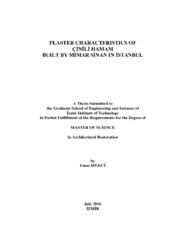Please use this identifier to cite or link to this item:
https://hdl.handle.net/11147/4873| Title: | Plaster characteristics of Çinili Hamam built by Mimar Sinan in İstanbul | Other Titles: | Mimar Sinan Tarafından İstanbul'da İnşa Edilen Çinili Hamamın Sıva Özellikleri | Authors: | İpekci, Emre | Advisors: | Böke, Hasan | Keywords: | Zeyrek Çinili Bath Mimar Sinan Istanbul Ottoman Empire Horasan plasters |
Publisher: | Izmir Institute of Technology Izmir Institute of Technology |
Source: | İpekci, E. (2016). Plaster characteristics of Çinili Hamam built by Mimar Sinan in İstanbul. Unpublished master's thesis, İzmir Institute of Technology, İzmir, Turkey | Abstract: | In this study, horasan and lime plasters of Zeyrek Çinili Bath (16th c.) in İstanbul built by Mimar Sinan, considered as the master architect of the Ottoman Empire, were investigated to determine application techniques of plasters, basic physical properties, raw material compositions, microstructural properties and hydraulicity of plasters, mineralogical, chemical compositions of binders, pozzolanic activities of crushed brick aggregates by using standard test methods, binocular microscope, XRD, SEM-EDS and TGA. Multilayered plaster application on the wall surfaces of the inner spaces of the bath was classified as lower level and upper level plasters. The lower level plasters are composed of two horasan plaster layers. The first layer is rough while the second layer is fine. Glazed tiles are adhered on the second layer of the horasan plasters by glazed tile adhesives. Hence, all horasan plasters are original and not repaired. The upper level plasters are composed of a horasan plaster layer with one or two lime plaster layers. The plasters of domes are consisted of a rough horasan plaster layer with one fine lime plaster layer. Horasan plasters used in all spaces of the bath have no significant differences in their physical properties, mineralogical, chemical compositions, microstructural properties, pozzolanicity and hydraulicity. Horasan plasters are high porous and low dense materials. The layers of horasan plasters used in the bath are well adhered to each other. Brick aggregates of horasan plasters have good puzzolanic properties. Hence, most of the horasan plasters are hydraulic. In this study, horasan and lime plasters of Zeyrek Çinili Bath (16th c.) in İstanbul built by Mimar Sinan, considered as the master architect of the Ottoman Empire, were investigated to determine application techniques of plasters, basic physical properties, raw material compositions, microstructural properties and hydraulicity of plasters, mineralogical, chemical compositions of binders, pozzolanic activities of crushed brick aggregates by using standard test methods, binocular microscope, XRD, SEM-EDS and TGA. Multilayered plaster application on the wall surfaces of the inner spaces of the bath was classified as lower level and upper level plasters. The lower level plasters are composed of two horasan plaster layers. The first layer is rough while the second layer is fine. Glazed tiles are adhered on the second layer of the horasan plasters by glazed tile adhesives. Hence, all horasan plasters are original and not repaired. The upper level plasters are composed of a horasan plaster layer with one or two lime plaster layers. The plasters of domes are consisted of a rough horasan plaster layer with one fine lime plaster layer. Horasan plasters used in all spaces of the bath have no significant differences in their physical properties, mineralogical, chemical compositions, microstructural properties, pozzolanicity and hydraulicity. Horasan plasters are high porous and low dense materials. The layers of horasan plasters used in the bath are well adhered to each other. Brick aggregates of horasan plasters have good puzzolanic properties. Hence, most of the horasan plasters are hydraulic.Bu çalışmada, Osmanlı İmparatorluğu'nun usta mimarı olarak anılan Mimar Sinan tarafından İstanbul‟da inşa edilen Zeyrek Çinili Hamam‟ın (16.yy) horasan ve kireç sıvaları, sıvaların uygulama teknikleri, fiziksel özellikleri, hammadde kompozisyonları, mikroyapısal özellikleri ve hidroliklikleri, bağlayıcıların mineralojik ve kimyasal kompozisyonları, agrega olarak kullanılan tuğla kırıklarının puzolanik aktiviteleri belirlenmesi için standart test metodları, binoküler mikroskop, XRD, SEMEDS ve TGA kullanılarak incelenmiştir. Hamam iç mekanlarının duvar yüzeylerindeki çok katmanlı sıva uygulama tekniği, alt seviye ve üst seviye sıvalar olarak sınıflandırılmıştır. Alt seviye sıvalar iki horasan sıva katmanından oluşur. İlk katman kaba sıva iken ikinci katman ince sıvadır. Çiniler horasan sıvaların ikinci katmanı üzerine çini yapıştırma harcı ile yapıştırılmıştır. Dolayısıyla, tüm horasan sıvalar orjinal ve onarım görmemiş durumdadır. Üst seviye sıvalar bir horasan sıva katmanı ve bir ya da iki kireç sıva katmanından oluşmaktadır. Kubbelerin sıvaları bir kaba horasan sıva katmanı ile bir ince kireç sıva katmanından oluşmaktadır. Hamamın tüm mekanlarında kullanılan horasan sıvaların fiziksel özellikleri, mineralojik, kimyasal kompozisyonları, mikroyapısal özellikleri, puzolaniklikleri ve hidroliklikleri önemli farklılıklar göstermemektedir. Horasan sıvalar çok gözenekli ve düşük yoğunluklu malzemelerdir. Hamamda kullanılan horasan sıvaların katmanları birbirine iyi yapışmış durumdadır. Horasan sıvaların tuğla agregaları iyi puzolanik özelliklere sahiptir. Dolayısıyla, horasan sıvaların birçoğu hidroliktir. |
Description: | Thesis (Master)--Izmir Institute of Technology, Architectural Restoration, Izmir, 2016 Full text release delayed at author's request until 2019.08.26 Includes bibliographical references (leaves: 79-83) Text in English; Abstract: Turkish and English xiii, 90 leaves |
URI: | http://hdl.handle.net/11147/4873 |
| Appears in Collections: | Master Degree / Yüksek Lisans Tezleri |
Files in This Item:
| File | Description | Size | Format | |
|---|---|---|---|---|
| T001531.pdf | MasterThesis | 6.47 MB | Adobe PDF |  View/Open |
CORE Recommender
Page view(s)
524
checked on Jun 10, 2025
Download(s)
354
checked on Jun 10, 2025
Google ScholarTM
Check
Items in GCRIS Repository are protected by copyright, with all rights reserved, unless otherwise indicated.